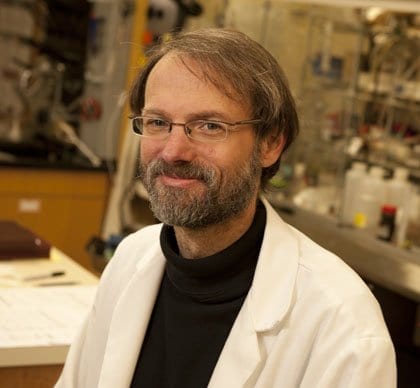
DGIST researchers are getting closer to developing a material that delivers a one-two punch: recycling atmospheric carbon dioxide for the production of cleaner hydrocarbon fuels.
Copper and platinum nanoparticles added to the surface of a blue titania photocatalyst significantly improve its ability to recycle atmospheric carbon dioxide into hydrocarbon fuels.
The modified photocatalyst was developed and tested by researchers at the Daegu Gyeongbuk Institute of Science and Technology (DGIST), with colleagues in Korea, Japan, and the US. It converted sunlight to fuel with an efficiency of 3.3% over 30-minute periods. This ‘photoconversion efficiency’ is an important milestone, the researchers report in their study published in the journal Energy and Environmental Science, as it means that large-scale use of this technology is becoming a more realistic prospect.
Photocatalysts are semiconducting materials that can use the energy from sunlight to catalyse a chemical reaction. Scientists are investigating their use to trap harmful carbon dioxide from the atmosphere as one of many means to alleviate global warming. Some photocatalysts are being tested for their ability to recycle carbon dioxide into hydrocarbon fuels like methane, the main component found in natural gas. Methane combustion releases less carbon dioxide into the atmosphere compared to other fossil fuels, making it an attractive alternative. But scientists have been finding it difficult to manufacture photocatalysts that produce a large enough yield of hydrocarbon products for their use to be practical.
Professor Su-Il In of DGIST’s Department of Energy Science and Engineering and his colleagues modified a blue titania photocatalyst by adding copper and platinum nanoparticles to its surface.
Copper has good carbon dioxide adsorption property while platinum is very good at separating the much-needed charges generated by the blue titania from the sun’s energy.
The team developed a unique set-up to accurately measure the catalyst’s photoconversion efficiency. The catalyst was placed in a chamber that received a quantifiable amount of artificial sunlight. Carbon dioxide gas and water vapour moved through the chamber, passing over the catalyst. An analyser measured the gaseous components coming out of the chamber as a result of the photocatalytic reaction.
The blue titania catalyst converts the energy in sunlight into charges that are transferred to the carbon and hydrogen molecules in carbon dioxide and water to convert them into methane and ethane gases. The addition of copper and platinum nanoparticles on the catalyst’s surface was found to significantly improve the efficiency of this process.
“The photocatalyst has a very high conversion efficiency and is relatively easy to manufacture, making it advantageous for commercialization,” says Prof. In. “
The team plans to continue its efforts to further improve the catalyst’s photoconversion efficiency, to make it thick enough to absorb all incident light, and to improve its mechanical integrity to enable easier handling.
Learn more: One-two-punch catalysts: trapping CO2 for cleaner fuels
The Latest on: Recycling atmospheric carbon dioxide
[google_news title=”” keyword=”recycling atmospheric carbon dioxide” num_posts=”10″ blurb_length=”0″ show_thumb=”left”]
via Google News
The Latest on: Recycling atmospheric carbon dioxide
- The Dirtiest Side of EVs: Rare Earths and Conflict Metalson April 26, 2024 at 2:43 pm
"Typical mining operations for rare earth mines vary from hard rock to heavy-mineral sands and ionic adsorption clay operations," de Jonge said. "For hard rock assets (the most common), metallurgy is ...
- MIT Technology Reviewon April 24, 2024 at 1:59 am
A world powered by electricity from abundant, renewable resources is now within reach.
- Race to zero wasteon April 22, 2024 at 5:53 am
UD has been part of the National Wildlife Federation’s Campus Race to Zero Waste competition, where scores of college campuses and several million students try to divert as much material away from ...
- Where does UC Berkeley's recycling go?on April 15, 2024 at 9:36 am
According to the Berkeley sustainability report, our campus performs significantly better than the average American, tossing about 0.8 pounds of waste per person per day in 2022, about half of ...
- Three Greenhouse Gases, Three All-Time Highson April 8, 2024 at 5:00 pm
The concentration of carbon dioxide in the atmosphere is now more than 50 percent ... Procter & Gamble and Nestlé say a new generation of recycling plants will help them meet environmental ...
- How Fishing Releases Huge Amounts of Carbon Dioxideon April 3, 2024 at 6:50 am
Last week, a team that included four of the same researchers published a follow-up: In addition to the acidification effect, over half of that carbon dioxide is then released into the atmosphere ...
- Can We Engineer Our Way Out of the Climate Crisis?on March 30, 2024 at 5:01 pm
In the atmosphere, carbon dioxide acts as a blanket ... Big brands like Procter & Gamble and Nestlé say a new generation of recycling plants will help them meet environmental goals, but the ...
- Biden plan gives these 3 Indiana companies money to cut carbon emissionson March 28, 2024 at 8:05 am
Real Alloy Recycling in Wabash will receive $ ... Once complete, the CCS technology will divert 2 million tons of carbon dioxide from the atmosphere to the underground storage site.
- Is Recycled Carbon The Answer To Decarbonising The Industrial Sector?on January 11, 2023 at 6:12 am
recycling 100 ... that can capture carbon emissions at their source - acting like a chimney filter that prevents the damaging molecules from escaping into the atmosphere. The CO2 can then be ...
- More than recycling: The six stages of a product’s environmental life cycleon December 7, 2022 at 4:23 pm
recycling waste products—waste carbon dioxide can be used to make fuel or even food. And with manufacturing often requiring large amounts of energy and water, brands like Garnier are looking to ...
via Bing News










